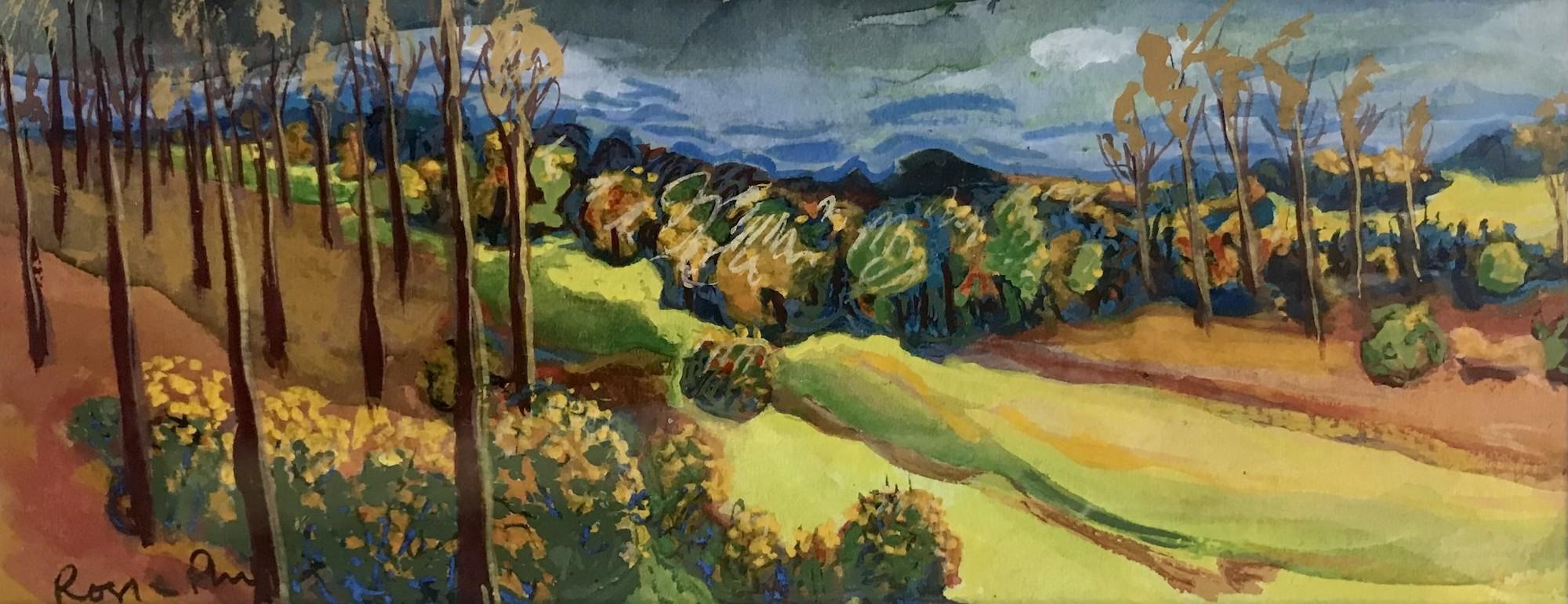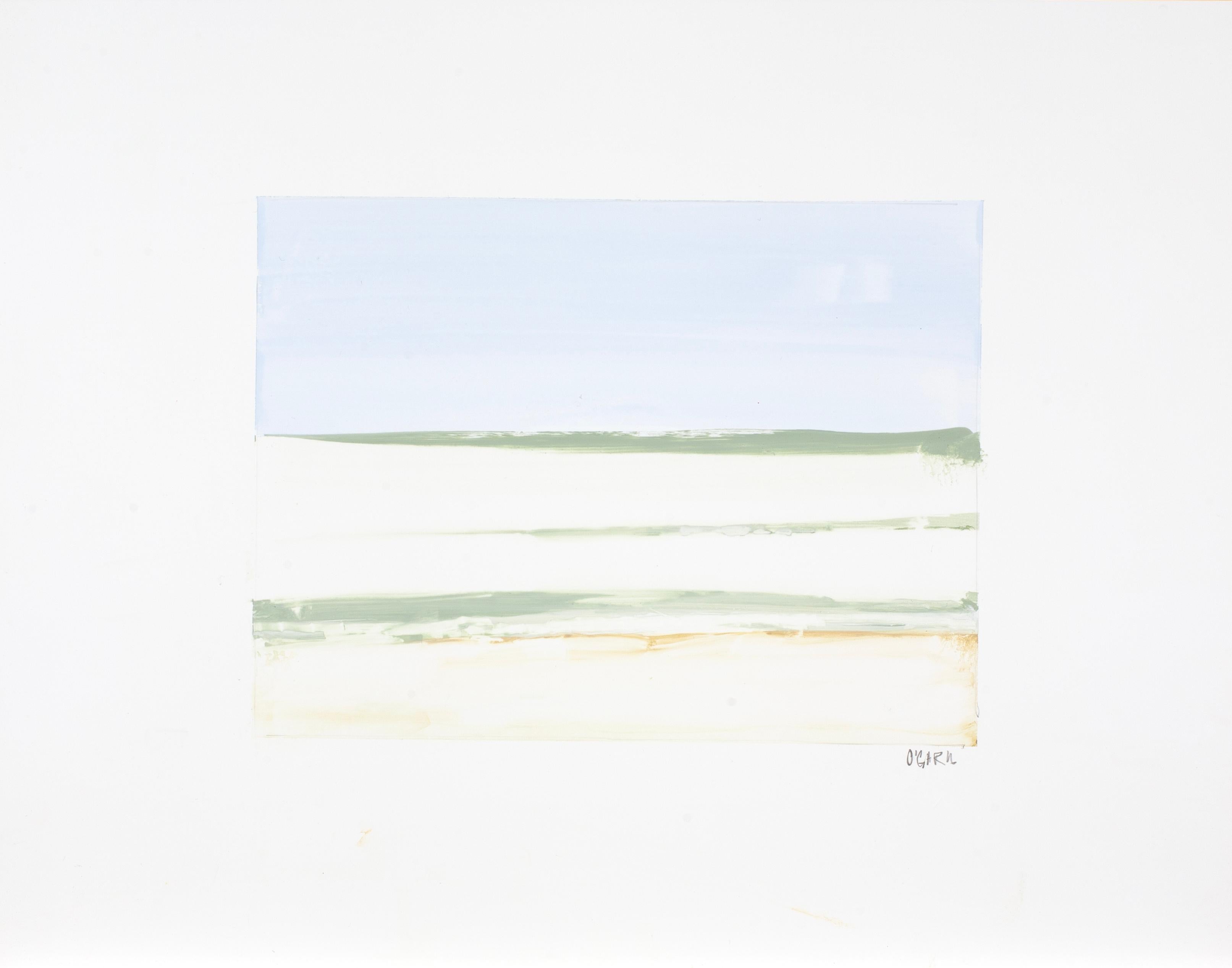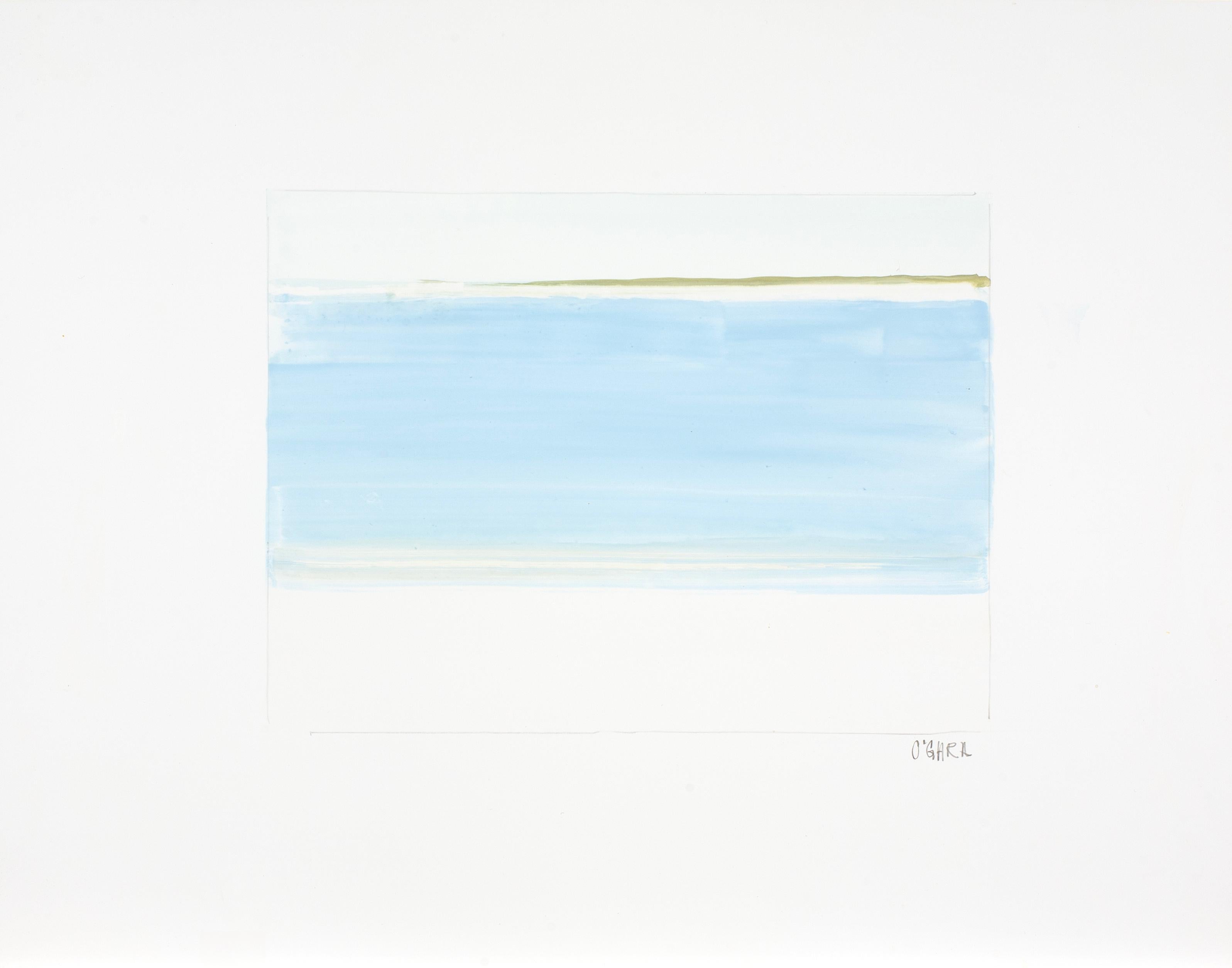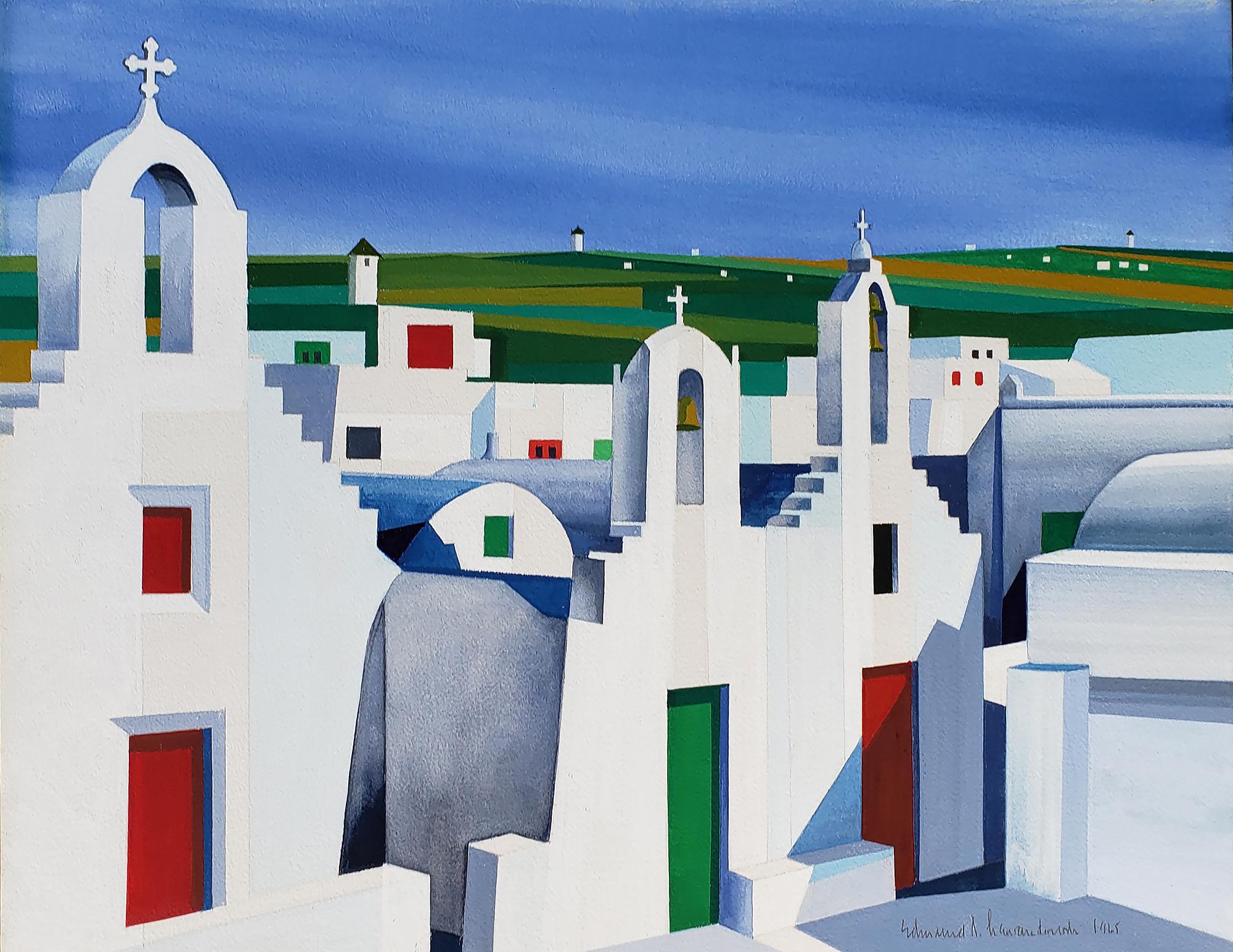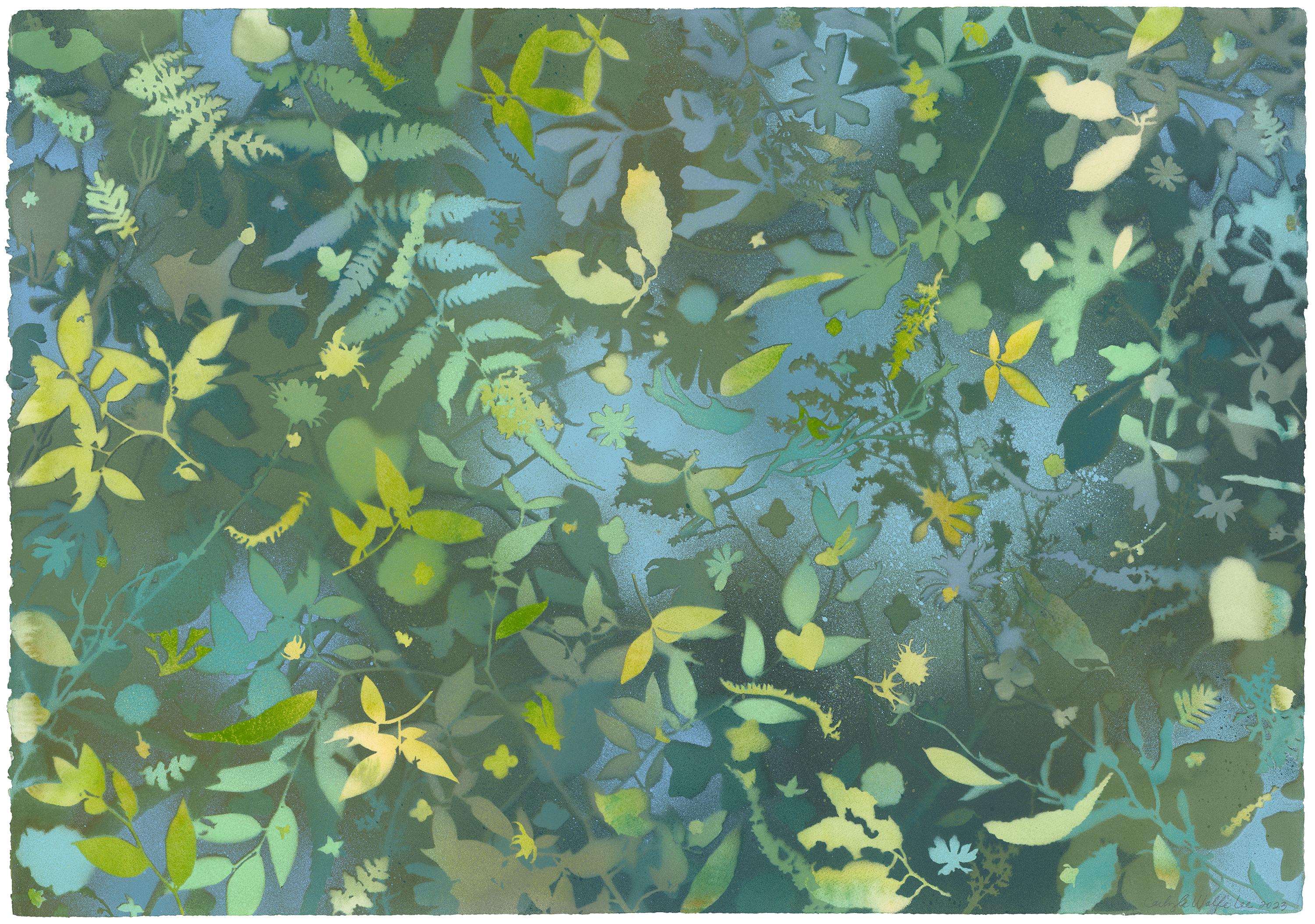Items Similar to Home, African Village Scene Orange Sky, African American Artist
Video Loading
Want more images or videos?
Request additional images or videos from the seller
1 of 13
Vincent D. SmithHome, African Village Scene Orange Sky, African American Artist1976
1976
About the Item
An African village scene is characterized by bold colors and a punchy flat orange sky combined with a post-impressionist paint application for the tree and the house. In the foreground, we see an African mother with two children standing outside her "Home." The work is created by African American artist Vincent D. Smith. It is signed lower right, Vincent, showing homage to Vincent Van Gogh, from whom the art word borrows some influence. Clearly, Smith has developed his own personal style, combining an African American persona with an African subject matter.
Original metal frame under glass.
The uploaded video is coming up light. Use the still image as a reference for color.
Vincent DaCosta Smith (December 12, 1929 – December 27, 2003) was an American artist, painter, printmaker and teacher. He was known for his depictions of black life.
Early life
Vincent DaCosta Smith was born on December 12, 1929, in the Bedford-Stuyvesant[1] neighborhood of Brooklyn, to Beresford Leopole Smith and Louise Etheline Todd. Both were immigrants from Barbados.[2] He was raised in Brownsville, Brooklyn and Smith drew what he saw around him.[citation needed] He attended an integrated school where he studied piano and the alto sax.
worked a range of jobs before he became a full-time artist. At 16, he worked for the Lackawanna Railroad repairing tracks. At 17, Smith enlisted in the army and traveled with his brigade for a year.[3] It wasn't until after his time in the army that Smith began to paint and printmaking.[4] At the age of 22, Smith was working in a post office where he grew to be friends with fellow artist Tom Boutis.[1]
Art education
Tom Boutis took Smith to a Paul Cézanne show at the Museum of Modern Art in 1951. After seeing the Cézanne show, Smith resigned from his position at the post office and began reading extensively about art.
He studied at the Art Students League of New York with Reginald Marsh.[citation needed]
Later, he began to sit in on classes at the Brooklyn Museum Art School, where the instructors would let him join in on the lessons and the criticisms.[3] After attending classes at the Brooklyn Museum Art School and the Art Students League of New York, he was accepted and received a scholarship to the Skowhegan School of Painting and Sculpture in Maine,[4] where he studied from 1953 to 1956.
Beginning in 1954,[5] he started taking official classes at the Brooklyn Museum Art School, and studied painting, etching, and woodblock printmaking.[4]
Career
Smith was a figurative painter who used abstractions and materiality to make something new.[6] Smith's work depicts the rhythms and intricacies of black life through his prints and paintings.[7] Many of his paintings and prints rely heavily on patterns.[6] According to Ronald Smothers, Vincent D. Smith's work "stood as an expressionistic bridge between the stark figures of Jacob Lawrence and the Cubist and Abstract strains represented by black artists like Romare Bearden and Norman Lewis."[7] Smith has described his own work as "a marriage between Africa and the West."[3] Over his life, he worked in both painting and printmaking.
In 1959, Smith won the John Hay Whitney Fellowship which allowed him to travel to the Caribbean for a year.[8] During this year he was deeply inspired by the customs and lifestyle of the native people.[8] Throughout his life, Smith attended various art schools but it was not until turning 50 he returned to college to earn an official degree.[7]
From 1967 until 1976 he taught at the Whitney Museum’s Art Resource Center.[2] Later in 1985, he taught printmaking at the Center for Art and Culture of Bedford Stuyvesant.
Death and legacy
Smith died in Manhattan on the December 27, 2003 from lymphoma and related complications.[7] Smith was aged 74.[7]
His work is included in many public museum collections including Art Institute of Chicago,[9] Newark Museum of Art,[1] Museum of Modern Art (MoMA),[1] Metropolitan Museum of Art,[1] Yale University Art Gallery,[10] Davidson Art Center,[11] Fitzwilliam Museum,[12] Brooklyn Museum,[13] Albright-Knox Art Gallery,[14] Rhode Island School of Design Museum,[15] among others.
Exhibitions
Over the course of his career, he had over 25 one-man shows and had his work shown in over 30 group shows.[7]
Vincent D. Smith had shown in a range of galleries and museums over his life-span. In 1970, he had his first individual exhibition at the Fisk University in Nashville, Tennessee. His first retrospective was in 1989 at the Schenectady Museum in Schenectady, New York.[2]
Solo shows:
1974 - The Portland Museum of Art, Portland, Maine[2]
1974 - Studio Museum in Harlem, New York, New York[2]
1989 - Schenectady Museum (Retrospective 1964-1989), Schenectady, New York
Awards and honors
This section needs additional citations for verification. Please help improve this article by adding citations to reliable sources in this section. Unsourced material may be challenged and removed. (May 2020) (Learn how and when to remove this template message)
1959 – John Hay Whitney Fellowship, John Hay Whitney Foundation, New York City, New York[8]
1967 – Artist in Residence, Smithsonian Conference Center
1968 – Grant, The American Academy and National Institute of Arts and Letters, New York
1971 – Creative Public Service Award for the Cultural Council Foundation, New York
1973 – National Endowment of the Arts and Humanities Travel Grant, New York
1973-1974 – Childe Hassam Purchase Award, American Academy of Arts and Letters, New York City, New York
1974 – Thomas P. Clarke Prize, National Academy of Design, New York
1981 – Windsor and Newton Award, National Society of Painters in Casein and Acrylic , New York.
1985-1986 – Artist-in-Residence, Kenkeleba House Gallery, New York.
Works
Below are some selected works:
Study for Mural at Boys and Girls High School, 1972, Metropolitan Museum of Art, New York, New York
A Moment Supreme, 1972, Metropolitan Museum of Art, New York, New York
The Triumph of B.L.S., 1973, Metropolitan Museum of Art, New York, New York
Jonkonnu Festival, 1996, Metropolitan Museum of Art, New York, New York
Murals
Mural for Crotona/Tremont Social Service Center, The Human Resource Administration, New York, New York 1980[1]
Mural for Oberia D. Dempsey Multi-Service Center of Central Harlem, New York, New York 1989[1]
Publications
Print portfolios
Impressions: Our World, Volume I (a portfolio of seven etchings - five with aquatint, two with embossing). Emma Amos, Benny Andrews, Vivian Browne, Eldzier Cortor, Norman Lewis, Vincent D. Smith, John Wilson (all were collaborating artists) (35 ed.). New York City, New York: Printmaking Workshop. 1974.[1]
Smith, Vincent D. (1994). Eight Etchings, 1965–1966 (40 ed.). G.W. Einstein Co., Inc.
Book illustrations
Amiri Baraka (LE Roi Jones) and Aminia Baraka The Music: Reflections on Jazz and Blues. William Morrow Company, New York, 1987[1]
Amiri Baraka; The Kaleidoscopic Torch, James B. Gwynne, ed., Stepping Stones Press, 1985[1]
Marguerite P. Dolch, Stories from Africa, Garrard Publishing Company, Campaign, Illinois, 1975[1]
References
Patton, Sharon (1990). Vincent D. Smith: Riding on a Blue Note:Monoprints and Works on Paper on Jazz Themes (exhibition catalogue). New York City, NY: Louis Abrons Arts Center, Henry Street Settlement. pp. 1970–1972.
Smith, V. D (1994). Vincent D. Smith: An appreciation : January 25-February 24, 1994, Robeson Center Art Gallery, Robeson Campus Center, Rutgers University. Robeson Center Gallery.
Smith, Vincent (15 November 1980). "A Painter Looks Back". New York Amsterdam News.
"Library Shows Work of Young Artist". New York Amsterdam News. 15 February 1958.
St. James Guide to Black Artists. Gale. 1997. pp. 499–501.
Cotter, Holland (26 September 2003). "Art in Review".
Smothers, Ronald (2004-01-03). "Vincent Smith, 74, Painter Who Portrayed Black Life". The New York Times. ISSN 0362-4331. Retrieved 2020-05-12.
"Whitney Fellowship Winners Announced". New York Amsterdam News. 27 June 1959.
"Vincent Smith". The Art Institute of Chicago. Retrieved 2020-05-12.
"Amnesty, Artist: Vincent DaCosta Smith, American, 1929–2003". Yale University Art Gallery, Yale University. Retrieved 2020-05-13.
"Vincent Dacosta Smith, Oooooooeeee Baby - DAC Collection Search". Davison Art Center, Wesleyan University. Retrieved 2020-05-13.
"Shadows in Harlem, 1965". The Fitzwilliam Museum. Retrieved 2020-05-13.
"Report from the Caucus Room, 1969". Brooklyn Museum. Retrieved 2020-05-13.
"Vincent DaCosta Smith". Albright-Knox Art Gallery. Retrieved 2020-05-13.
"Vincent Dacosta Smith, First Day of School, 1965". RISD Museum. Retrieved 2020-05-13.
- Creator:Vincent D. Smith (1929 - 2003, American)
- Creation Year:1976
- Dimensions:Height: 16.5 in (41.91 cm)Width: 15.25 in (38.74 cm)
- Medium:
- Movement & Style:
- Period:
- Condition:
- Gallery Location:Miami, FL
- Reference Number:1stDibs: LU385314350292
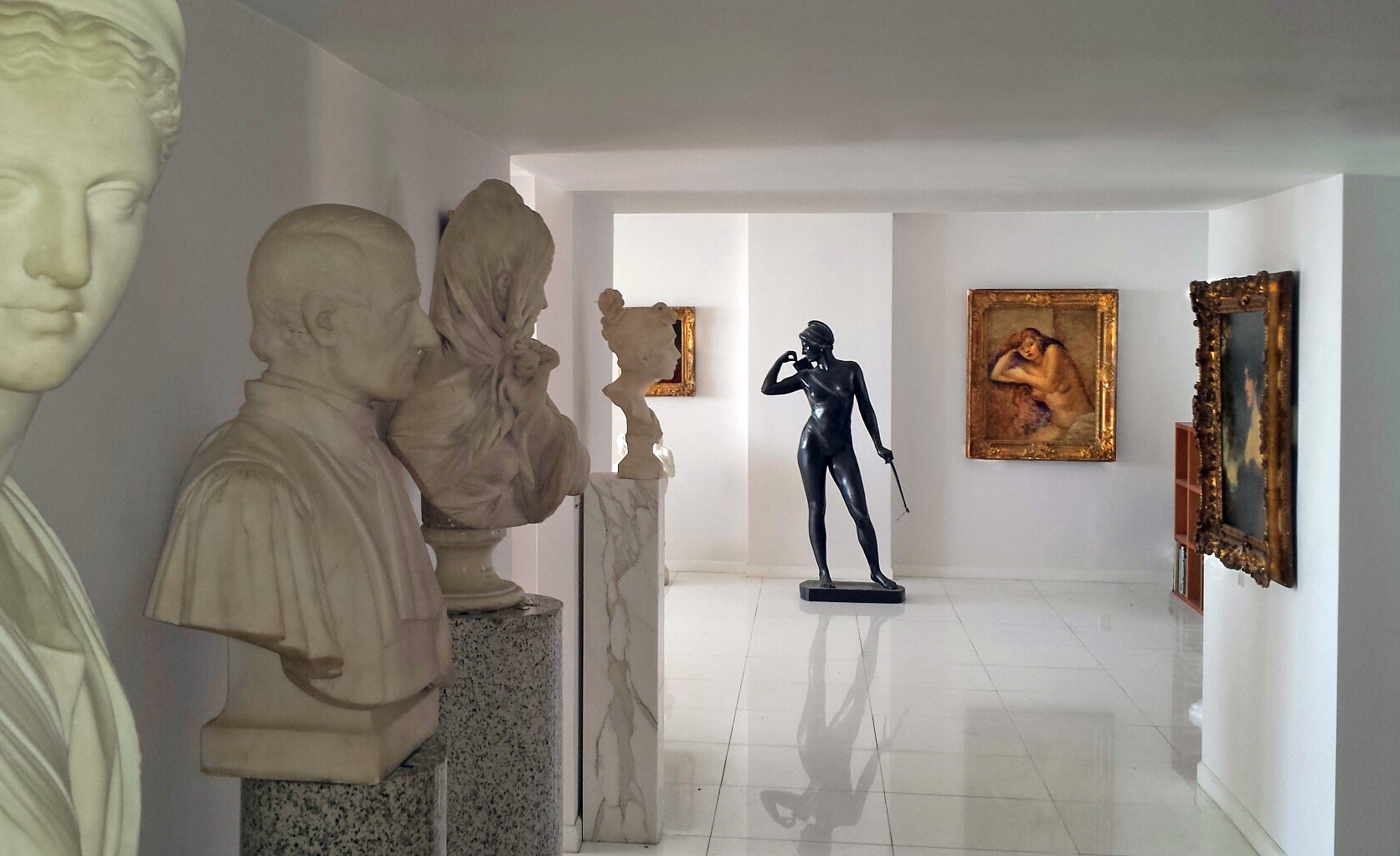
About the Seller
4.9
Gold Seller
These expertly vetted sellers are highly rated and consistently exceed customer expectations.
Established in 2005
1stDibs seller since 2016
102 sales on 1stDibs
Typical response time: 1 hour
- ShippingRetrieving quote...Ships From: Miami, FL
- Return PolicyA return for this item may be initiated within 3 days of delivery.
More From This SellerView All
- Mykonos Church LandscapeBy Edmund LewandowskiLocated in Miami, FLA vibrant example of the artist's precisionist style where a tight semi-abstract geometric composition is inspired by architecture and is reduced to simplified geometric shapes with...Category
1960s Abstract Geometric Landscape Paintings
MaterialsGouache, Board
- Thought Provoking Rock Quarry - Mid Century AbstractLocated in Miami, FLThis meticulously planned, designed, and executed work depicts an ultra-wide angle view of a rock quarry/mine. The viewer looks down at close-up-stylized rock formations and then out at a horizon line with rust-colored mine trestles. Atherton hints at perspective with a broken white line that is wider in the foreground and tapers to a hairline as it recedes to the background. The work was done in 1951 at the height of America's most important art movement: Abstract Expressionism. John Atherton absorbs its influences but retains elements of representation. Atherton was an in-demand commercial artist who worked for most blue-chip clients. It is possible that this was an editorial assignment for Fortune Magazine. At the same time, Atherton was also a fine artist and the work could be an expression of pure creative pursuits. The work looks better in person and one can look at it for hours and not get bored. Look carefully and you may discover a deeper meaning in this painting of precisely arranged rocks. Signed lower right. Brooklyn Museum of Art, New York, sold to benefit the acquisitions program ____________________ From Wikipedia, the free encyclopedia John Carlton Atherton (January 7, 1900 - September 16, 1952) was an American painter and magazine illustrator, writer and designer. His works form part of numerous collections, including the Museum of Modern Art,[1] Whitney Museum of American Art and the Smithsonian American Art Museum.[2][3][4] Early Years He was the son of James Chester Atherton (1868-1928) and Carrie B. Martin (1871-1909). He was born in Brainerd, Minnesota.[5] His father was Canadian born. His parents relocated from Minnesota to Washington State, with his maternal grandparents whilst he was still an infant. He attended high school in Spokane, Washington. Career During his early years he never displayed an aptitude for art; rather, his first love being nature and the activities he relished there, mainly fishing and hunting. He enlisted in 1917, serving briefly in the U.S. Navy for a year during World War I. At the end of the war, determined to get an education he worked various part-time jobs, as a sign painter and playing a banjo in a dance band to pay his enrolment fee at the College of the Pacific and The California School of Fine Arts (now the San Francisco Art Institute). Once there, he also worked in the surrounding studios developing his oil painting techniques. A first prize award of $500 at the annual exhibition of the Bohemian Club in 1929, financed his one way trip to New York City, which helped to launch his career as an artist.[6] Atherton had aspired to be a fine artist, however his first paid jobs were for commercial art firms designing advertisements for corporations such as General Motors, Shell Oil, Container Corporation of America, and Dole. However, by 1936, encouraged primarily by friends, such as Alexander Brook, an acclaimed New York realist painter, he returned to the fine arts. Atherton continued to accept numerous commissions for magazine illustrations; such as Fortune magazine, and over the years he would paint more than forty covers for The Saturday Evening Post starting with his December 1942 design, “Patient Dog.” This picture is reminiscent of his friend Norman Rockwell ‘Americana style’ and captures a poignant moment of nostalgia, where a loyal dog looks toward a wall of hunting equipment and a framed picture of his owner in military uniform. Selected One person Exhibitions Atherton accomplished his first one-man show in Manhattan in 1936. His Painting, “The Black Horse” won the $3000 fourth prize from among a pool of 14,000 entries. This painting forms part of the Metropolitan Museum of Art collection in New York.[7] Atherton achieved recognition in New York City and elsewhere during the 1930s. Having exhibited at the Julien Levy Gallery in New York,[8] his paintings began to be collected by museums; including the Museum of Modern Art[9] and the Metropolitan Museum of Art. His reputation increased with his art deco stone lithograph poster for the 1939 New York World's Fair. In 1941, his design won first place in the Museum of Modern Arts “National Defense Poster Competition”. Selected Public Collections Fleming Museum of Art, Burlington, Vermont Albright-Knox Art Gallery,[10] Buffalo, NY Art Institute of Chicago,[11] Chicago Wadsworth Atheneum,[12] Hartford, CT Brooklyn Museum of Art, New York Metropolitan Museum of Art, New York The Museum of Modern Art,[13] New York Whitney Museum of American Art,[14] New York Pennsylvania Academy of the Fine Arts,[15] Philadelphia De Young Museum,[16] San Francisco Smithsonian American Art Museum,[17] Washington DC Butler Institute of American Art[18] Youngstown, OH The Famous Artists School Founded in 1948 in Westport, Connecticut, U.S.A. The idea was conceived by members of the New York Society of Illustrators (SOI), but due to the Society's legal status, could not be operated by it. SOI member Albert Dorne led the initiative to set up a separate entity, and recruited the support of Norman Rockwell, who was also an SOI member. For the founding faculty, Dorne recruited Atherton, as well as accomplished artists such as Austin Briggs, Stevan Dohanos, Robert Fawcett, Peter Helck, Fred Ludekens, Al Parker, Norman Rockwell, Ben Stahl, Harold von Schmidt and Jon Whitcomb.[19] He collaborated with Jon Whitcomb with the book “How I Make a Picture: Lesson 1-9, Parts 1”.[20][21] Society of Illustrators Atherton as an active member from his arrival in New York. The society have owned many of his works. Ex-collection includes: Rocking Horse (ca. 1949) [22] Atherton, as his peers had many of his works framed by Henry Heydenryk Jr.[23] Personal On November 2, 1926, he married Polly “Maxine” Breese (1903-1997).[24][25] They had one daughter, Mary Atherton, born in 1932. Atherton's often chose industrial landscapes, however found himself spending considerable time in Westport, Connecticut, with an active artistic community, and it became home for him, and his family. He then moved to Arlington, Vermont.[26] Norman Rockwell enlisted Atherton in what was to be the only collaborative painting in his career.[27] He was part of a group of artists including a Norman Rockwell, Mead Schaeffer and George Hughes who established residences in Arlington.[28] Atherton and Mead Schaeffer were avid fly fishermen and they carefully chose the location for the group,[29] conveniently located near the legendary Battenkill River. In his free time, Atherton continued to enjoy fly-fishing.[30] He brought his artistic talent into the field of fishing,[31] when he wrote and illustrated the fishing classic, “The Fly and The Fish”.[32] He died in New Brunswick, Canada in 1952,[33] at the age of 52 in a drowning accident while fly-fishing.[34] Legacy The Western Connecticut State University holds an extensive archive on this artist.[35] His wife, Maxine also published a memoir “The Fly Fisher and the River” [36] She married Watson Wyckoff in 1960. Ancestry He is a direct descendant of James Atherton,[37][38] one of the First Settlers of New England; who arrived in Dorchester, Massachusetts in the 1630s. His direct ancestor, Benjamin Atherton was from Colonial Massachusetts...Category
1950s Abstract Expressionist Abstract Paintings
MaterialsMixed Media, Gouache, Board
- New York Skyline the West Side with Hudson River - Vintage New YorkBy Frank S. HermannLocated in Miami, FLRooftop view of the upper West Side Manhattan as it looked in the 1930s. There is a rough indication of a billboard and a glimpse of the Hudson River. The cluster of buildings depic...Category
1930s American Impressionist Landscape Paintings
MaterialsGouache, Board, Oil
- City Scape Abstract Expressionist Composition -Jackson Pollack FriendBy Joseph MeertLocated in Miami, FLThe fame, notoriety, and monetary value of an artist's work in today's market are not based on one's talent and vision. Factors such as marketing and media momentum play a defining r...Category
1940s Abstract Expressionist Abstract Paintings
MaterialsGouache
- Moody Sunset Synchronized with Crashing WaveBy Frederick Arthur BridgmanLocated in Miami, FLThe artist captures a magical moment where the sun wanes behind a bank of clouds as a wave crashes on the beach. One pictorial element recedes while the other advances. In 1875, it ...Category
1980s Impressionist Landscape Paintings
MaterialsCanvas, Oil
- Morningside Park, New York - Cathedral of St. John the DivineBy Lucille CorcosLocated in Miami, FLCorcos paints what appears to be the northern part Central Park from an elevated view looking northwest. The artist used a restricted palette of warm browns and grays with heavy outl...Category
1920s Modern Landscape Paintings
MaterialsCanvas, Masonite, Oil
You May Also Like
- Hidden by Clouds, Original Landscape Painting, Cotswolds Rural ArtworkBy Rosie PhippsLocated in Deddington, GBHidden by Clouds is an original framed painting by artist Rosie Phipps. Featuring her gestural and expressive use of mark making to create these beautifully intimate landscapes. Rosi...Category
21st Century and Contemporary Post-War Landscape Paintings
MaterialsPaper, Watercolor, Gouache
- Yellow SubmarineBy Chet La MoreLocated in Palm Desert, CAA painting by Chet la More. "Yellow Submarine" is a painting, acrylic on canvas in a palette of blues, whites, and yellows by American, Post-War artis...Category
Mid-20th Century Post-War Landscape Paintings
MaterialsCanvas, Acrylic
- Landscape Abstract No. 1Located in Columbia, MOMary Jo O’Gara is based in Winnetka, Illinois, where she keeps her own studio and teaches painting at the North Shore Art League. An alumna of Marquette University, Evanston Art Cent...Category
21st Century and Contemporary Abstract Abstract Paintings
MaterialsGouache
- Landscape Abstract No. 2Located in Columbia, MOMary Jo O’Gara is based in Winnetka, Illinois, where she keeps her own studio and teaches painting at the North Shore Art League. An alumna of Marquette University, Evanston Art Cent...Category
21st Century and Contemporary Abstract Abstract Paintings
MaterialsGouache
- 'Light on Water I' - naturalist landscape, colorful, botanical, layered, greenBy Carlyle Wolfe LeeLocated in Atlanta, GA"Light on Water I" is a soothing naturalist landscape featuring hues of blue, green and yellow. This work is framed in a simple white frame behind Museum Glass measuring 37 by 49 inc...Category
2010s Contemporary Abstract Paintings
MaterialsGouache, Archival Paper
- 'Anniversary Wildflowers II' naturalist landscape, colorful, botanical, layeredBy Carlyle Wolfe LeeLocated in Atlanta, GA"Anniversary Wildflowers II" is a colorful naturalist landscape featuring hues of purple, pink, orange and green. This work is framed in a simple white frame behind Museum Glass meas...Category
2010s Contemporary Abstract Paintings
MaterialsGouache, Archival Paper
Recently Viewed
View AllMore Ways To Browse
Art By African American
African American Vintage
Vintage African American Art
African American Art Signed
Modern African Artists
Vintage Inspired Home
African Americans Subject
Vintage African Painting
Dior Not War
African American Culture
African Stone Art
West African Art
Metal Skier
Vincent Artist
African Metal
Make Art Not War
Original Art African American
African American Artists Prints
